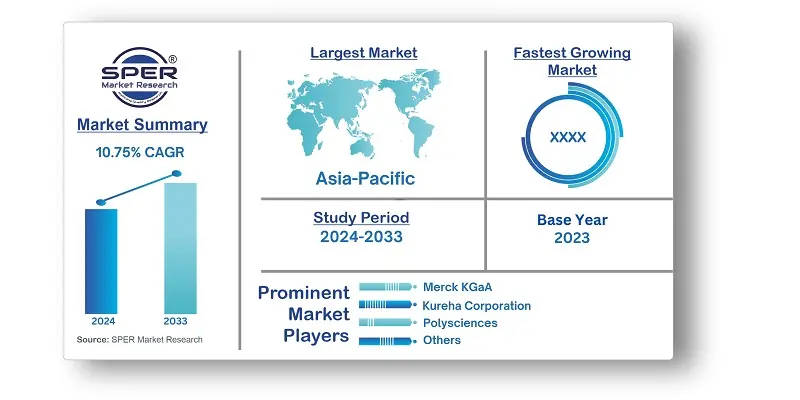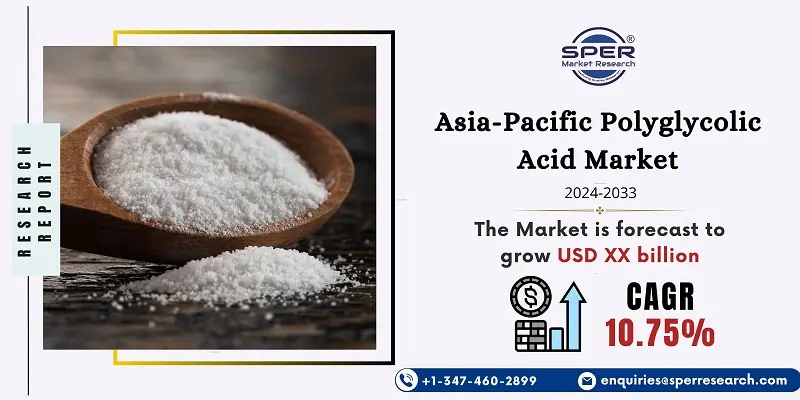
Asia-Pacific Polyglycolic Acid Market Trends, Share, Size, Demand, Revenue and Future Outlook
Asia-Pacific Polyglycolic Acid Market Growth, Size, Trends Analysis- By Form, By End User- Regional Outlook, Competitive Strategies and Segment Forecast to 2033
| Published: Oct-2024 | Report ID: CHEM2496 | Pages: 1 - 156 | Formats*: |
| Category : Chemical & Materials | |||
- January 2024: The National Mission on Sustainable Packaging Solution's presentation was declared by the Council of Scientific and Industrial Research (CSIR). The mission expects to foster answers for manageable packaging.
- October 2022: BASF announced to build Neopentyl Glycol plant at Zhanjiang Verbund site in China with an annual production capacity of 80,000 metric tons.
- September 2022: BASF offered neopentyl glycol and propionic acid with product carbon footprint of zero.


| Report Metric | Details |
| Market size available for years | 2020-2033 |
| Base year considered | 2023 |
| Forecast period | 2024-2033 |
| Segments covered | By Form, By End User. |
| Regions covered | Australia, China, Indonesia, India, Malaysia, Philippines, South Korea, Thailand, Japan, Singapore, and the Rest of Asia-Pacific. |
| Companies Covered | BMG Incorporated, Haihang Industry Co, Huizhou Foryou Medical Devices Co, Kureha Corporation, Merck KGaA, Orion Sutures India Pvt Ltd, Polysciences. |
- Medical Device Manufacturers
- Pharmaceutical Companies
- Biotechnology Firms
- Research Institutions
- Agricultural Sector
- Packaging Industry
| By Form: | |
| By End User: |
- Asia-Pacific Polyglycolic Acid Market Size (FY’2024-FY’2033)
- Overview of Asia-Pacific Polyglycolic Acid Market
- Segmentation of Asia-Pacific Polyglycolic Acid Market By Form (Fibres, Films and others)
- Segmentation of Asia-Pacific Polyglycolic Acid Market By End User (Medical, Oil & Gas, Packaging and others)
- Statistical Snap of Asia-Pacific Polyglycolic Acid Market
- Expansion Analysis of Asia-Pacific Polyglycolic Acid Market
- Problems and Obstacles in Asia-Pacific Polyglycolic Acid Market
- Competitive Landscape in Asia-Pacific Polyglycolic Acid Market
- Impact of COVID-19 and Demonetization on Asia-Pacific Polyglycolic Acid Market
- Details on Current Investment in Asia-Pacific Polyglycolic Acid Market
- Competitive Analysis of Asia-Pacific Polyglycolic Acid Market
- Prominent Players in Asia-Pacific Polyglycolic Acid Market
- SWOT Analysis of Asia-Pacific Polyglycolic Acid Market
- Asia-Pacific Polyglycolic Acid Market Future Outlook and Projections (FY’2024-FY’2033)
- Recommendations from Analyst
1.1. Scope of the report1.2. Market segment analysis
2.1. Research data source
2.1.1. Secondary Data2.1.2. Primary Data2.1.3. SPERs internal database2.1.4. Premium insight from KOLs
2.2. Market size estimation
2.2.1. Top-down and Bottom-up approach
2.3. Data triangulation
4.1. Driver, Restraint, Opportunity and Challenges analysis
4.1.1. Drivers4.1.2. Restraints4.1.3. Opportunities4.1.4. Challenges
4.2. COVID-19 Impacts of the Asia-Pacific Polyglycolic Acid Market.
5.1. SWOT Analysis
5.1.1. Strengths5.1.2. Weaknesses5.1.3. Opportunities5.1.4. Threats
5.2. PESTEL Analysis
5.2.1. Political Landscape5.2.2. Economic Landscape5.2.3. Social Landscape5.2.4. Technological Landscape5.2.5. Environmental Landscape5.2.6. Legal Landscape
5.3. PORTERs Five Forces
5.3.1. Bargaining power of suppliers5.3.2. Bargaining power of buyers5.3.3. Threat of Substitute5.3.4. Threat of new entrant5.3.5. Competitive rivalry
5.4. Heat Map Analysis
6.1. Asia-Pacific Polyglycolic Acid Market Manufacturing Base Distribution, Sales Area, Product Type6.2. Mergers & Acquisitions, Partnerships, Product Launch, and Collaboration in Asia-Pacific Polyglycolic Acid Market
7.1. Asia-Pacific Polyglycolic Acid Market Size, Share and Forecast, By Form, 2020-20267.2. Asia-Pacific Polyglycolic Acid Market Size, Share and Forecast, By Form, 2027-20337.3. Fibres7.4. Films7.5. Others
8.1. Asia-Pacific Polyglycolic Acid Market Size, Share and Forecast, By End User, 2020-20268.2. Asia-Pacific Polyglycolic Acid Market Size, Share and Forecast, By End User, 2027-20338.3. Medical8.4. Oil & Gas8.5. Packaging8.6. Others
9.1. Asia-Pacific Polyglycolic Acid Market Size and Market Share
10.1. Asia-Pacific Polyglycolic Acid Market Size and Market Share By Region (2020-2026)10.2. Asia-Pacific Polyglycolic Acid Market Size and Market Share By Region (2027-2033)10.3. Australia10.4. China10.5. Indonesia10.6. India10.7. Malaysia10.8. Philippines10.9. South Korea10.10. Thailand10.11. Japan10.12. Singapore10.13. Rest of Asia-Pacific
11.1. BMG Incorporated
11.1.1. Company details11.1.2. Financial outlook11.1.3. Product summary11.1.4. Recent developments
11.2. Haihang Industry Co
11.2.1. Company details11.2.2. Financial outlook11.2.3. Product summary11.2.4. Recent developments
11.3. Huizhou Foryou Medical Devices Co
11.3.1. Company details11.3.2. Financial outlook11.3.3. Product summary11.3.4. Recent developments
11.4. Kureha Corporation
11.4.1. Company details11.4.2. Financial outlook11.4.3. Product summary11.4.4. Recent developments
11.5. Merck KGaA
11.5.1. Company details11.5.2. Financial outlook11.5.3. Product summary11.5.4. Recent developments
11.6. Orion Sutures India Pvt Ltd
11.6.1. Company details11.6.2. Financial outlook11.6.3. Product summary11.6.4. Recent developments
11.7. Polysciences
11.7.1. Company details11.7.2. Financial outlook11.7.3. Product summary11.7.4. Recent developments
11.8. Others
SPER Market Research’s methodology uses great emphasis on primary research to ensure that the market intelligence insights are up to date, reliable and accurate. Primary interviews are done with players involved in each phase of a supply chain to analyze the market forecasting. The secondary research method is used to help you fully understand how the future markets and the spending patterns look likes.
The report is based on in-depth qualitative and quantitative analysis of the Product Market. The quantitative analysis involves the application of various projection and sampling techniques. The qualitative analysis involves primary interviews, surveys, and vendor briefings. The data gathered as a result of these processes are validated through experts opinion. Our research methodology entails an ideal mixture of primary and secondary initiatives.



Frequently Asked Questions About This Report
PLACE AN ORDER
Year End Discount
Sample Report
Pre-Purchase Inquiry
NEED CUSTOMIZATION?
Request CustomizationCALL OR EMAIL US
100% Secure Payment






Related Reports
Our Global Clients
Our data-driven insights have influenced the strategy of 200+ reputed companies across the globe.




















